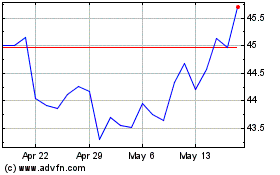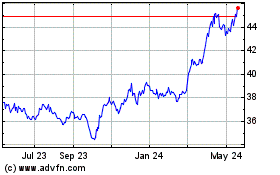Three Best Gold ETFs - Commodity ETFs
December 06 2011 - 4:01AM
Zacks
As the future of the U.S dollar as global reserve currency
remains uncertain, many investors—both here and abroad—have begun
to diversify their assets out of greenbacks and into other mediums.
While euros and other currencies such as the yen were popular for a
while, the structural problems facing those economies are becoming
extremely apparent to nearly every investor, forcing many to
consider alternatives for diversification exposure. Ultimately,
this quest tends to end up with the precious metals market, and
more specifically, gold.
The precious metal remains a great diversifying agent for
portfolios and a quality hedge for those looking to protect against
broad market declines or a collapse in the dollar. Yet, while gold
can be easily purchased online or at a local bullion dealer, there
are some issues that one has to be aware off before going down this
path. First, one must consider the wide spreads that dealers have
for the precious metals, which are sometimes in excess of 5%. This
added fee, which is generally on both sides of the transaction, is
a heavy cost to bear for most investors and especially those
dealing with small quantities of gold. Furthermore, there is also
the issue of storage; unless one wants to throw their gold in the
sock drawer, a safe or safety deposit box must also be purchased,
again adding to the total costs incurred by precious metal
investors (also see Avoid Turmoil With The Community Bank ETF).
Thanks in part to these issues, investors have begun to embrace
ETFs as a trading tool that can offer the same exposure to gold but
without many of the headaches outlined above. Trading is available
throughout the day on all of these products, bid/ask spreads are
extremely tight, and fees, thanks to intense competition, have been
pushed to rock-bottom levels. However, investors should note that
there are quite a few choices in the space and while all of them
have their selling points, they are not created equal by any means.
In light of this, we decided to take a closer look at three of our
favorite products in the gold ETF space below:
SPDR Gold Shares
(GLD)
For investors seeking extreme levels of liquidity, GLD is tough
to beat in the gold space. The fund has over $71 billion in AUM and
trades close to 17.2 million shares a day. In other words, the
trust behind GLD holds more gold in its reserve than the nations of
China or Switzerland, enough to put it in fifth if it were a
sovereign country. Obviously with numbers like this it shouldn’t
surprise anyone to know that the product trades almost as much in a
day as all the other gold ETFs combined. However, investors should
note that the product has expenses at the higher end of the scale
in the gold ETF space, as the annual fee is 0.4%. Furthermore,
investors should note that from time to time, the product isn’t
100% allocated to gold and can thus deviate slightly from the
performance of the metal when markets are oscillating wildly. For
performance, GLD has gained 20% since the start of the year and has
lost 4.3% over the past three months (see Is USCI The Best
Commodity ETF?).
iShares Gold Trust
(IAU)
If expenses are your primary concern, IAU is the gold standard
in this corner of the market. The fund charges just 0.25% in
expenses per year, making it the lowest by far in the category.
Investors should also note that the product allocates 100% of its
assets to gold on a daily basis, ensuring a very accurate picture
in terms of tracking error. For volume, the levels are pretty
solid; IAU trades a little over 8.6 million shares a day. While
this is good, it is obviously far less than GLD, suggesting that
wider bid/ask spreads may be possible in this product (although it
is unlikely). Additionally, investors should note that the product
trades in increments of 1/100th of an ounce, giving it a
far lower price per share than either of the other two products on
the list which employ a 1/10th of an ounce of gold
methodology instead. In terms of performance, IAU has slightly
edged out GLD gaining 20.1% in year-to-date terms but it has led on
the downside as well, falling by 4.3% over the past three months
(also see Top 3 Best Performing Precious Metals ETFs).
ETFS Physical Swiss Gold Shares
(SGOL)
SGOL is an interesting product in the gold space as it can’t
compete with either fund on volume—trading less than 200,000 shares
a day—nor can it really compete on price as expenses are 0.39% a
year. Still, the product has developed a cult following
thanks to its unique storage system, allowing the fund to rack up
close to $1.8 billion in assets. While the other gold ETFs hold
securities in London, and North America, SGOL holds all of its gold
in the nation of Switzerland. Specifically, all of the bullion is
held in secure vaults in Zurich, a major city in the small
landlocked country in Europe. This appears to have tempted
investors who are worried about a gold confiscation program hitting
the U.S. again, or those that are just looking to spread their
assets around to one of the world’s premier banking destinations
(see The Best Commodity ETF For 2011 And 2012).
For performance, SGOL has finished in the middle of the pack in
year-to-date terms, gaining a tad over 20%. However, in terms of
the last three months, SGOL has actually beaten out its
counterparts by a few basis points, as the product has lost about
4.25% in the time period, thanks in part to SGOL trading at a
slight premium to NAV. Nevertheless, this desire to move assets to
Switzerland-based vaults appears to have, at least in the short
term, allowed SGOL to beat out its counterparts in the gold ETF
space.
Want the latest recommendations from Zacks Investment Research?
Today, you can download 7 Best Stocks for the Next 30
Days. Click to get this free report >>
Author is long IAU and gold bullion.
Zacks Investment Research
Want the latest recommendations from Zacks Investment Research?
Today, you can download 7 Best Stocks for the Next 30 Days. Click
to get this free report
iShares Gold (AMEX:IAU)
Historical Stock Chart
From Jun 2024 to Jul 2024

iShares Gold (AMEX:IAU)
Historical Stock Chart
From Jul 2023 to Jul 2024
